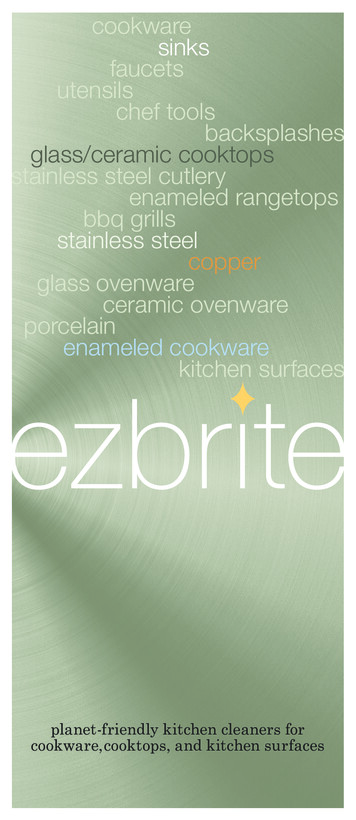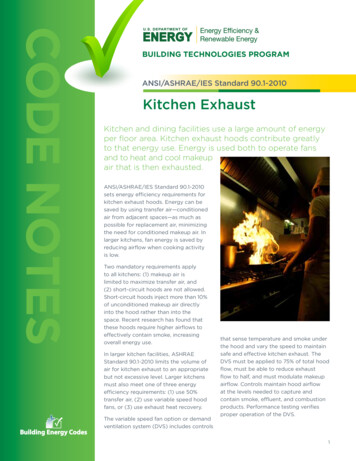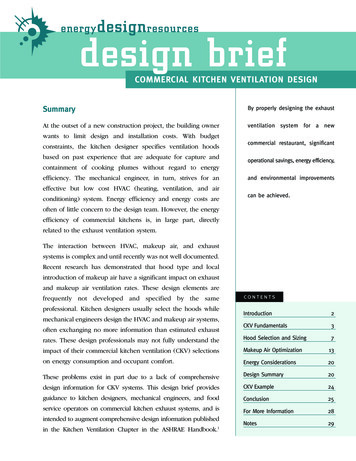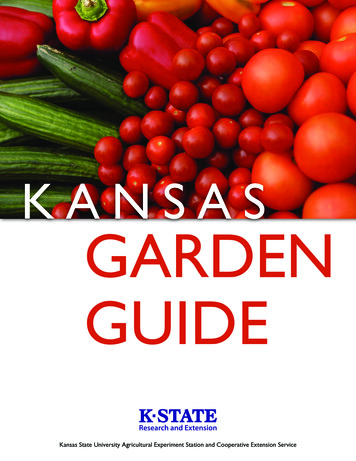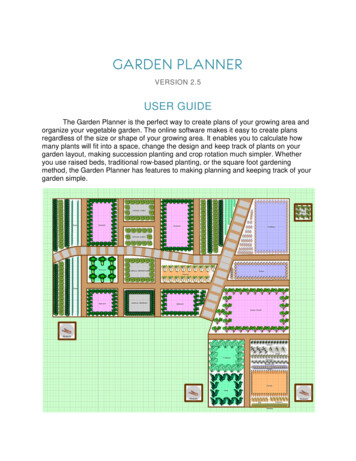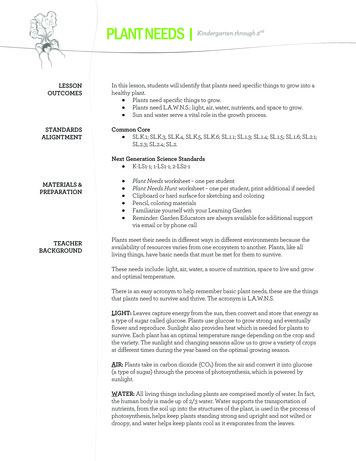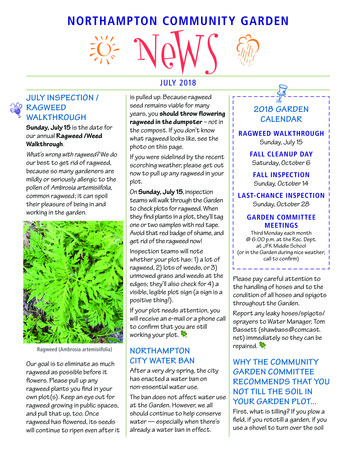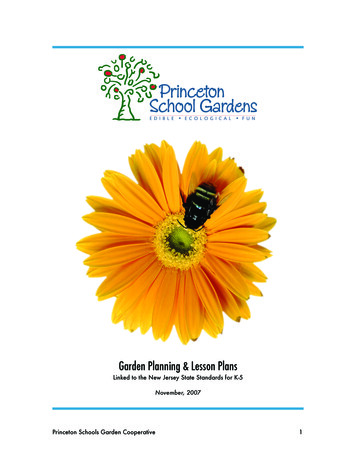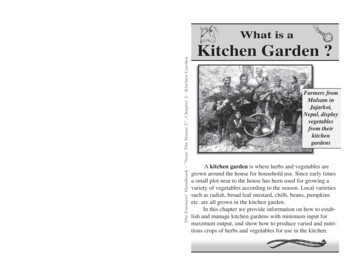
Transcription
The Farmers' Handbook - "Near The House 2", Chapter 2 - Kitchen GardenWhat is aKitchen Garden ?Farmers fromMulsam inJajarkot,Nepal, displayvegetablesfrom theirkitchengardensA kitchen garden is where herbs and vegetables aregrown around the house for household use. Since early timesa small plot near to the house has been used for growing avariety of vegetables according to the season. Local varietiessuch as radish, broad leaf mustard, chilli, beans, pumpkinsetc. are all grown in the kitchen garden.In this chapter we provide information on how to establish and manage kitchen gardens with minimum input formaximum output, and show how to produce varied and nutritious crops of herbs and vegetables for use in the kitchen.
Whymake aKitchen Garden ?For people to stay healthy it's very important to have ahealthy diet. A healthy diet means a balanced mix of rice,bread, pulses, vegetables, herbs, fruit etc. Vegetables are avery important part of a good diet as they contain variousnutrients for many body functions. For growing, energy andprotection against disease, vegetables play an essential role.Vegetables are especially important for the young, and forpregnant and nursing women.Benefits of the Kitchen Garden to grow healthy, fresh vegetables yourself; to save the cost of buying vegetables and herbs; waste resources such as sweepings, kitchen scraps anddirty water can be recycled onto the garden; wasteland around the house can be made productive.This Booklet's Author :Chris Evans, advisor,Himalayan Permaculture Group, Nepalwww.designedvisions.com2The Farmers' Handbook, "Near The House - 2"Howto make aKitchen Garden ?Because there's often no tradition of kitchen gardens,many people can't grow the vegetables they need for a gooddiet. Or they spend lots of money on vegetables, or theirhealth suffers from lack of vegetables.It may be that you haven't been able to make a kitchengarden. There are several reasons why it may be difficult tomake a kitchen garden, or if youhave made one, it is not successful. For example: pests, diseases or livestockhave destroyed the crop; no good seed or seedlings; lack of space;These vegetables lack of water;have wilted because of lack of lack of fertility;water no spare time; lack of the right skills.In this chapter easy methods are described to solve these sorts of problems, and so helpthe family to be able to grow good produce from their kitchengarden.Chapter 2 - Kitchen Garden3
Beneficial Connections in the Kitchen Gardena collecting waste waterbsweepings pitc home nursery (hotbed, fruit nursery, etc.)e living fencedair nurseryffence (not living)g vegetable bedshliquid manureiWorking relationships in theKitchen Gardenilivestock stall1How to make the work easierin the Kitchen Garden1 domestic waste watercollection3 seeds from the garden tohouse and from house togarden2 ash, water, hair, etc.composting resources from thehouse to the land4 sweepings from thehouse and courtyard5 waste water used for irriga- 6 use of composttion in the kitchen garden8 fodder from the landand live fence, and7 liquid manure also used tocompost returned tocontrol pests and diseasethe landmulchmaterialfromthe910 vegetables etc. fromlive fence and edgesthe kitchen gardento the house4The Farmers' Handbook, "Near The House - 2"2384abc10g9658d7hefChapter 2 - Kitchen Garden5
Things to pay attention toTo make and manage a kitchen garden easily, and to givebest production, the following things are important :1. Site selection3. Water management5. Seed & seedlings2. Protection4. Fertility6. Design of the garden2. Protection The kitchen garden area needs protection from the very start. It should not bepossible for livestock to enter the area. Apermanent fence should be made. Thornyplants can be cut and used to make afence, but the best method is to plant aliving fence to protect the garden.Good management of the garden needs knowledge of allthese. Then we can make our kitchen garden more successful.1. Site selectionIf you already have a kitchen garden you may not needto choose a new site, it's enough to improve the old site. Ifyou are making a new garden, there are many factors to consider. For example : how to protect from livestock ? how can you bring water to the site and distributeit ? how is the soil ? How can the fertility needs bemanaged ? where is the sunlight coming from ? how can the area be accessed easily from the house ? Then, the crops within the garden will also need protectionfrom damage by many types of pest and disease. There aremany ways to do this. Mixed cropping, rotations, liquid manure, etc. are all ways of protecting crops. There is more information about crop protection in the chapter Integrated PestManagement.When these issues are considered, the best site can bechosen and the work of making the garden will be easier.6The Farmers' Handbook, "Near The House - 2"Chapter 2 - Kitchen Garden7
3. Water MangementIt is important to provide enough moisture for thekitchen garden. There are many ways of conserving and increasing the moisture available. For example : Mulching : prevents the wind and sun drying the bare soil; Green Manures : also cover the soil, and so help inconserving water; Windbreak : wind will dryout the soil, so stopping thewind helps to conserve soilmoisture;wind Provide shade : in the hot season trees can provide shadeto the kitchen garden. A few small trees, such as Lucaena,mulberry, Moringa (drumsunshinestick), Persian lilac, or evenfruit trees in the fence or withinthe garden can be used for this.As well as giving shade, thesetrees can also provide otherbenefits, such as firewood,fodder or mulch material. Mist collection : mist collects on theleaves of trees around and within thekitchen garden, and drips onto the soilto provide extra moisture.8 Irrigation : if there is no irrigationfor main food crops, it is likelythat there is also not enough waterto irrigate the kitchen garden. Butif the above methods are used,then more water is conserved andso less is needed. Collecting andusing waste water from the kitchencan be enough to water the garden. Also, direct water fromcommunal tapstands can be used on kitchen gardens.The Farmers' Handbook, "Near The House - 2"Guidelines for IrrigationBy only putting a little water over a wide area, only thesurface will be kept moist. This can cause roots to stay nearthe soil surface and in strong sun they can dry out very easily.So it's much better to irrigate less area with more water, so themoisture goes deeper in the soil. Then this area will not needwatering again for a long time. In the hot season, irrigate inthe evening or at night, and not in the daytime.Deep wateringis better fordeep rooting,and irrigationis needed lessoften.Shallow watering meansroots stay at the surfaceand will soon dry out.Chapter 2 - Kitchen Garden9
Let's SeeHow to make aKitchen GardenKitchen garden protected inside a wovenbamboo fence.Plantingmixed vegetables helps toprotect themfrom pests anddiseases.Even chickens can'tget through thisfence made fromwormwood stalks.Edge plants provide useful mulchclose to the gardenbeds where theyare needed.Near thehouse manytypes of foodplants can begrown in thesame place.passionpassion fruitfruitchilli10broad beanIn mixed vegetable planting,no space iswasted and thesoil is alwayscovered.corianderThe Farmers' Handbook, "Near The House - 2"Chapter 2 - Kitchen Garden11
4. FertilityAll farmers know that without fertility in the soil, cropswon't grow. But fertility can be as limited as water. If thereisn't enough compost for the field crops, it can't be taken andused for the kitchen garden. So our kitchen garden needs tobe self reliant for fertility. Suggestions for sources of fertilityare given below : Sweepings pit :- by collecting everyday sweepings from the house and yardin one place, you can make enoughcompost for the kitchen garden. Liquid manure :- liquid manuremade in a pit or a drum gives nutrients to the plants as well as protecting them from pests and diseases. Mulching :- putting a thick layer ofbiomass mixed with compost on thesoil helps to increase fertility. Green manures :- sowing seeds ofgreen manure helps to protect the soiland gives extra fertility for more production12The Farmers' Handbook, "Near The House - 2" Legumes :- planting legumes such aspeas, beans, Sesbania, sun hemp, etc.,provides extra nitrogen to the soilwhich is good for other crops Other sources :- ash, oil seed cake,hair etc. are all resources which canbe added to the soil to increase fertility, as well as helping to prevent pestsand disease.5. Seeds and SeedlingsA kitchen garden can provide very good food from local,traditional vegetables, and it's important not to lose theselocal varieties. However, sometimes farmers are also interested to try new varieties. So it's very important to save andprotect any good seed - this is the farmer's responsibility. Information aboutseed saving is given in the Seed Savingchapter. From good seed, it is importantto be able to raise good, healthy seedlings for transplanting into the kitchen garden.Nursery techniques are described in the Home Nursery, Airnursery, Hot bed and Leaf Pots chapters.13Chapter 2 - Kitchen Garden
6. Garden Design More production in a small place1Planting lots of varietiescan give good productionin a small area2456871191331012If seeds and seedlings are planted too wide apart, muchof the space in between goes to waste, where weeds willgrow. Weeds use precious water and compost, and cause extrawork to keep clear. You also have to work harder to replacethe water and compost which are lost to the weeds. This iswhy it's best to plant vegetables densely. But if only one typeof vegetable is planted densely, it will compete with itself forspace above and below ground, and so not be a good crop. Soit's better to plant a mix of small and large types, to makedifferent layers of crops on the same bed. These will alsohave different layers of roots in the soil.This means many plants can be grown in a small space,but there is no competition between crops for space, waterand nutrients. SuccessionAs smaller vegetables are harvested for food, thismakes space for the longer lasting vegetables, while inbetween new seedlings can be planted.Succession1 broad bean4 peas3 oniontomato6 corianderSwiss chard9 beetroot7 cauliflowergarlic10 carrot12 comfreymarigold13 new seedlings - see "succession" on the next page25811Newly plantedcauliflowerseedlingsSpecies not shown, but also possible to plantPreviously plantedbroad leafmustard seedlingsVegetables :- cabbage, kale, radish, turnip, kohl rabi, chilli,broad leaf mustard, spinach, lettuce, aubergine, beans, etc.Vegetable or herb companion plants :- fennel, dill, basil, tansy, etc.14The Farmers' Handbook, "Near The House - 2"Chapter 2 - Kitchen Garden15
Edge PlantingIt's not only the making of the kitchen garden, we must alsobe able to maintain it easily. It can be fun to create and plant agarden, but having to work every day to maintain it may soonbecome difficult, and so the garden gets neglected. Edge planting helps to make maintenance work easy in the kitchen garden."Edge planting" means the growing of support crops, orcompanion plants, in the edges around the garden and itsbeds. These plants help support the garden by providingmulch, protection from weeds, windbreaks, repelling pests,and producing other useful resources. Plants such as wormwood, Adhatoda vasica, marigold, comfrey, lemon grass,nettles, Lucaena, mulberry, basil, tansy, and many others aregood for edge planting.Benefits of Edge PlantingEdge planting helps with protecting the garden and alsoproducing fodder, fuel, nectar for bees, herbs for medicines, soilconservation (terrace stabilisation), habitat for pest predators, etc.Edge plantstake nutrientsfrom deep inthe soil andcycle them tothe surface,where theyare used asmulch, andthen returnedto the soil.16The Farmers' Handbook, "Near The House - 2"Beneficialpredator insectstake nectar fromthe flowers.Then theyattack pestinsects.The smell of marigoldflowers and leaves helpto repel many types ofpest insect. They alsoproduce a substancefrom their roots whichrepels damaging soilnematodes.Where to plant ? in fences in agro-forestry on terrace edges on the edges of vegetable beds on path edges around the edge of the courtyard on the edge of thecompost heap, waste water pit, sweepings pit, path, etc.Chapter 2 - Kitchen Garden17
Farmers'ExperienceSubjects Related to Kitchen GardenMr Shyam Shrestha ownsSunrise Farm in Sita Paila4, Kathmandu, Nepal. Hehas experience makingkitchen gardens, so let'shear his story.This book provides enough information to be able tomake and manage your own kitchen garden. However, thisinformation is also linked to other methods. For extra benefitslet's read, learn and practice from these related chapters.At first I used to farm thetraditional way but doing this,one type of vegetable wasgrown all together so thereShyam Shresthawere more pest problems, andmore maintenance was neededas well. I've been collecting waste water from the kitchen forirrigation. For compost, I collect the rubbish around the houseand cow shed into a sweepings pit. When I plant varioustypes of vegetables mixed together, there are less pest problems. There's less weeding too, because they're planted soclosely, and I mulch where I can. When I harvest, I clearwhatever weeds there are and mulch them back on the beds that's more compost. I collect seed from the best plants ofeverything. With this method, I plant once and then need verylittle work or maintenance - just harvesting, and eating.Nowadays, others are starting to learn these methods here for vegetable gardening themselves.æ18Read On !Mr Shyam ShresthaÆThe Farmers' Handbook, "Near The House - 2"MulchingchapterMixed VegetableGardening chapterLivingFencechapterKitchen GardenchapterSweepingsChapterIntegrated PestManagementchapterHome NutritionchapterCompostchapterChapter 2 - Kitchen GardenWasteWater chapterGreen Manureschapter19
Mulching chapter :- how to grow more crops with lesswork while keeping the soil coveredIntegrated Pest Management chapter :- how to uselocal resources and knowledge in many different methods ofcontrolling pests and diseasesSeed Saving chapter :- information on methodsto produce and store various quality seeds at home.Sweepings chapter :- how to make good compostfrom sweeping the house and yard.Waste Water chapter :- how to get irrigation for thegarden from domestic waste water.Green Manures chapter :- sow a green manure seedsto add fertility to the soil and produce more cropsCompost chapter :- information on how to make goodcompost quickly is given in this chapterLiquid Manure chapter :- how to use local plants tomake a liquid for fertilizer and pest controlNutrition chapter :- information about needs andsources of a healthy diet for all the family.Living Fence chapter :- how to plant not just a fence butalso produce fodder, fuelwood, mulch and other benefitsHome Nursery chapter :- make nurseries from localresources to grow many types of plants at homeGrihasthi CommunicationsMixed Vegetable Gardening :- how to grow lots ofvegetables easily by planting many varieties at one time
To make and manage a kitchen garden easily, and to give best production, the following things are important :-Good management of the garden needs knowledge of all these. Then we can make our kitchen garden more successful. 1. Site selection 3. Water management 5. Seed & seedlings 2. Protection 4. Fertility 6
